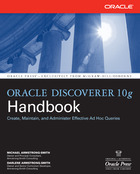EUL backups - now there's a novel concept. Let me tell you a story.
Just over a year ago I consulted to a large organization and created a new EUL with a couple of business areas. It took three weeks to complete. On the Friday when I was leaving I migrated the whole lot from Dev to Prod and left.
About 11am on Monday morning I received a call that went something like this: Michael, hello, how are you? Ummm - Discoverer deleted itself from production. Don't you find that odd? Why does it do that?
Well you can't kid a kidder. Because I know the tool so well I said - it cannot just delete itself - either the owner or someone who knows the EUL owner's password must have logged in and told Discoverer to delete the EUL.
No admissions of guilt were offered - naturally. I mean - would you own up to having deleted your company's production reporting system on the same day that it went live? Perhaps booking a one-way ticket to Australia (sorry oz - but I am English) would be in order.
No problem - I said - go to your Prod backup and restore your EUL schema. You'll soon be back up and running.
Ah - they said - here's the second problem - we forgot to put the EUL schema into the backup routine.
Hmm - I said - in that case all you have to do is go to your Dev instance, export the EUL and then import it into Prod.
Ah - they said - here's the third problem - we refreshed Dev from Prod on Sunday afternoon and it also does not contain an EUL.
Oops - I said - when do you want me to come back?
Let us think about it - they said - and we'll call you back.
They did call me back and I informed them that before I left on Friday I had taken a backup myself of the EUL in Dev and told them where it was on their server.
Phew - they said - thank you, thank you. Oh and by the way the DBA admitted to having dropped the EUL schema on Friday evening as he thought it was a user messing about!
I recount this story as a warning to everyone else - please make sure your EUL schema is included in your backups. A good administrator should also take periodic exports of the EUL - just in case!
Anyone else got a similar horror story - hopefully with a happy ending?
By the way - I'm in Boston this week and I can't find a decent English cup of tea anywhere. In years gone by we would have gone to war over that. Oh - we did - and we lost. Methinks I'd better keep a low profile.
Battle in India for e-commerce market leadership is no longer between just
Amazon and Flipkart
-
Amazon Launches Prime Music in India. What It Means for the Indian
e-commerce Market
O
n a day when it was reported that the online streaming music app Ga...
5 years ago





